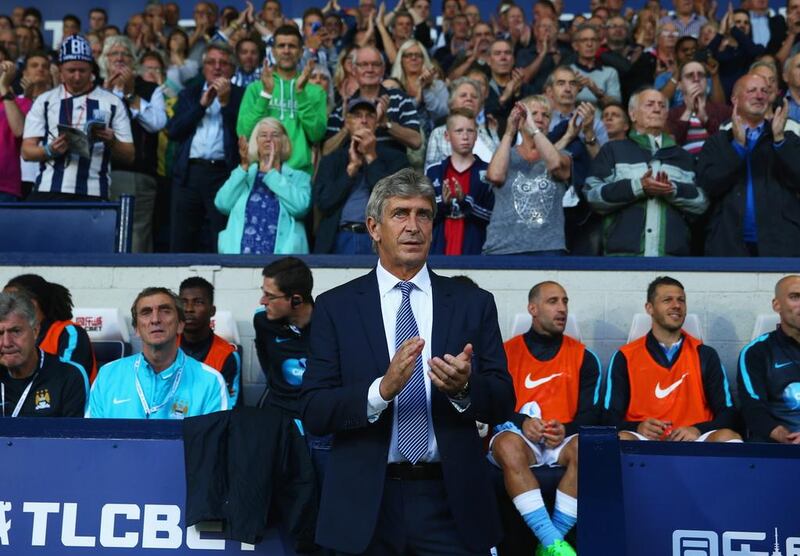Bournemouth had just been promoted in scintillating style. They had scored 98 goals. Only one man, it seemed, was going on the defensive. Manager Eddie Howe, discussing his tactics, said in May: “I don’t like calling it 4-4-2. There is a stigma with that.”
A month into the new Premier League season, Howe is the only top-flight manager playing 4-4-2. He may object to that depiction because centre-forward Callum Wilson tends to start in a more advanced position than his supporting acts, either Josh King or Lee Tomlin.
His shape could be called 4-4-1-1, and Howe may not admit it, but he is fighting a lone battle to protect an endangered species: the strike partnership.
Centre-forwards once were given an ally automatically. Even foreign managers such as Fabio Capello and Sven-Goran Eriksson selected a duo when in charge of the England team.
They found their teams outnumbered in midfield at World Cups, illustrating the failings of the 4-4-2. But the stereotypical combinations of a big man and a small man, or a target man and a finisher, seemed entrenched.
Richard Jolly: One-dimensional Jesus Navas is 'obvious fall guy' in Kevin de Bruyne's Man City arrival
Now, apart from the odd dalliance with a back three — which can allow a manager to field two forwards — the shift in systems seems complete. An unthinking adherence to 4-4-2 was once the “English disease”. Now the default shape is 4-3-3, whether in the form of 4-3-3, 4-2-3-1 or 4-1-4-1.
A tactical trend has underpinned a remarkable change in results. Home wins have become rarities in the Premier League, with only 10 in 40 matches so far. Just one was accomplished when starting with a 4-4-2 formation, and Sunderland were so awful that their ineptitude, rather than Leicester City’s shape, might seem the determining factor in that.
Only Manchester City and Swansea City have 100 per cent home records so far. In contrast, Arsenal, Crystal Palace and West Ham United, like Manuel Pellegrini’s team, have successive wins on the road. City, West Ham, Liverpool and Everton have yet to concede an away goal.
The key, perhaps, lies in the control that extra midfielder affords. The trio Liverpool fielded — Lucas Leiva, Emre Can and James Milner — in the 0-0 draw at Arsenal could all be deemed defensive, in their duties if not the way two of them play.
In some cases, it amounts to a defensive shield, particularly with the popular double pivot in front of the back four. In others, it offers the ability to retain possession.
The key to away wins, and there have been 16 so far, lies in the ability to marry two facets of play: a solid base and counter-attacking pace. A lone striker requires support, but it has to arrive quickly.
With fewer out-and-out forwards, speedy midfielders have a greater onus to chip in with goals. Many of the away wins have been notable for their scoring contributions: Wilfried Zaha and Bakary Sako in Palace’s twin triumphs, Manuel Lanzini for West Ham at Anfield, Pedro for Chelsea against West Bromwich Albion and Samir Nasri for City at Goodison Park.
More notable are the goals provided by attacking full-backs such as Steven Whittaker, Joel Ward, Cesar Azpilicueta and Aleksandar Kolarov in away wins. With two holding midfielders, they have more licence to attack.
If West Ham, with no points at home and six away, seem to symbolise the changing times, perhaps the most significant switch has come from the league leaders. Pellegrini clung to 4-4-2 long after most others had abandoned it, but he was made to look alarmingly naive when City lost successive matches to Barcelona and Liverpool in the spring.
The Chilean is too obstinate to admit he has changed tack, arguing an attacking style has been a constant, but City’s tactics are sounder now.
As for the almost anachronistic strike duo, it now feels like Plan B.
Swansea beat Manchester United — at home — after a second-half rethink when manager Garry Monk implemented a diamond midfield and two forwards. West Brom manager Tony Pulis brought on a second striker, Rickie Lambert, who set up Salomon Rondon’s winner at Stoke City, but only after the hosts were reduced to nine men. They no longer needed a fifth midfielder.
FOLLOW US ON TWITTER @NatSportUAE






